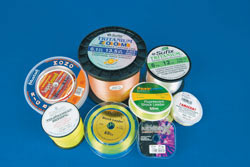Whenever I hook a decent fish and it starts heading off to the horizon, there is one thing that always runs through my mind – will my line cope with the pressure? If the line is new, then the risk of the line breaking will be considerably lower. But, if your line has been used over a couple of sessions then there might be a weak spot, such as a nick or even a burn from a thumb slip during a cast. And that could be the difference between landing that fish of a lifetime or having yet another story about the one that got away.
Changing your lines every session will certainly increase your confidence in landing any fish but this can be a bit costly, not to mention the hassle it creates every time you prepare for your session. The secret is to find yourself a good-quality line that you are confident with. This does not necessarily have to be an expensive version but one that is matched to your angling and chosen venue. When you choose a new line there are three main factors you should look for. The first is to choose one that sits well on the reel for good casting performance, especially if you are using a powerful casting style. The type of line that suits this application is one that has little memory, as it has less springiness when it leaves the reel, which will result in less overruns.
The next factor is high knot strength. All your lines will require a knot, whether it is to a shockleader or direct to a swivel on a rig and this is often the weakest link between you and the fish. To reduce this risk you can use specialist knots such as the Bimini twist or a spider hitch. Tied properly these knots can offer up to 100 per cent of the breaking strain of the line you are using. These lines, once again, tend to be those with little memory as they are soft and supple. Hard mono can easily burn as the knots are tightened and they can also be brittle when put under heavy tension. Your final consideration has to be your chosen venue. If you are fishing marks where there is any rough ground or snags, you will require a line that can withstand the punishment of being constantly dragged through this type of terrain. Even the cleaner beaches can do unseen damage to your lines, especially if it is being pulled over sand bars or up the side of a gully. To understand what is happening, just imagine what would happen to your line if you were to rub it with a sheet of sandpaper!
To be honest, it is hard to spot a good line on the tackle-shop shelves and the only way you will find the right one is by trial and error, or maybe recommendation. However, if abrasion resistance is your main concern then I would certainly forget the softer lines and choose one that is much stiffer and has a higher diameter for its breaking strain.
Low-diameter lines will put extra yards on your cast.
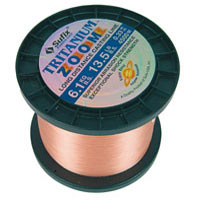 |
Light-Line Advantage
Running line is measured in diameter and breaking strain and for most clean-beach fishing scenarios I would go for a diameter of 0.35mm, which is generally around 15lb breaking strain. However, the more you spend on a line, usually the lower the diameter you can get for the same breaking strain. For example, a cheap line could be as much as 0.40mm for 15lb breaking strain, whereas a more specialist line can give you the same breaking strain with a diameter as low as 0.30mm! To explain the advantage of this, you have to imagine that you are fishing at range in a fast tide on a clean beach. A heavy line will pick up much more tide than the thinner line and will more than likely make it tricky for you to hold out in the tide. Whereas the lower-diameter lines will have less surface area and will certainly lessen the pulling effect of the tide. A lower-diameter line will also allow you to cast further, especially with multiplier reels. This is because, on a multiplier, the spool will spin slower as the diameter of line on the spool drops slower. Whereas with a higher-diameter line the level drops quickly and causes the spool to rotate faster, which is a sure way to increase the risk of overruns.
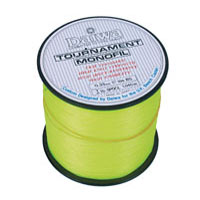 |
| Barney’s favourite field-casting line is the reliable Daiwa Tournament. |
Tough Lines
When fishing over rough ground with no need for long-range casting, there will be a need for heavier-diameter main lines, but not necessarily heavier breaking strain. This is because a thicker line can withstand much more abrasion when it is dragged through the rough stuff. For this type of angling I would recommend choosing cheaper lines with a high diameter. A good example of this is a 30lb line with a diameter of around 0.50mm, because this offers enough strength to do the job, as well as being thick enough to withstand the abrasion factor. However, if you are using a thicker-diameter line on a multiplier reel, you will have to tune your reel to suit the speed of the spool’s rotation. All you have to do is increase the braking power of either the magnets, if your reel has them, or ensure that the reel has all the centrifugal brakes fitted. If you are still experiencing problems with overruns then try adding thicker oil to the reel’s bearings and tighten the spool-tensioning knob.
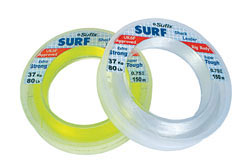 |
| A good-quality shockleader is a must for any style of cast. |
Shock Absorbers
I cannot express enough the importance of using suitable leaders with regards to safety. A shockleader is essential when performing any kind of cast from the shore because when a cast is made there is a massive amount of stress put on the line from the lead, bait and casting style. Therefore, you must ensure that you use a minimum of 50lb breaking strain when casting weights from 4oz to 5oz. A good guide is to remember that for every ounce of lead you are casting you will need a minimum of 10lb breaking strain leader. Personally, I never use anything less than 80lb for all my general beach fishing, as this increases the safety factor and allows for any minor damages to the leader. I have tried numerous leaders over the years, but for reliability and performance I now only use those from the Sufix range. These are used extensively within the casting world, but more importantly I have great confidence in these lines. If I were to try another line I would ensure that it had a minimum of 0.80mm diameter and be at least 80lb breaking strain. With regard to colour, I prefer clear leaders and I use the exact same material for all my rig bodies. This is because I like to give fish the credit that a coloured line might be visible to them.
How To Tie The Leader Knot… for how to tie the leader knot, use the drop down menu above to access Total-Fishing.com’s Knot Section
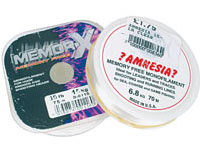 |
| Memory-free lines, such as Amnesia and Memor-X, are the best snood lines money can buy. |
Snood Lines
There are dozens of different snood lines to choose from and the only considerations here are to try and match the line to your intended quarry and the conditions. If you are fishing for small fish, maybe in a match situation, then I would go as light as possible and stick with clear lines. But be warned that if you go too light you will find that the line will be prone to tangling around the rig body, especially in strong tides. For most general angling situations a good-quality line, in either 20lb or 25lb, will provide the best results. If the ground is a little rough, or the fish you are targeting have good dentures, then it would be wise to increase the breaking strain to something like 30lb or 35lb. Line manufacturers have paid special attention to snood lines over recent years and there are now several varieties that are perfect for the job.
These tend to be those with little memory, such as the Amnesia or Memor-X brands. The reason that these are so good is that they ensure perfect bait presentation, which is simply because they resist kinks and line twisting. Even when the rigs have been coiled up in a rig wallet, or if a hooked fish twists itself around the rig, a slight stretch of the snood will straighten the line and be ready to fish again. Fluorocarbon lines have also become extremely popular with sea anglers, simply because they are almost invisible in the water. However, fluorocarbon does have its downsides, such as being expensive, and it is only effective when used in clear water. Another problem is that these lines tend to be stiff and brittle, which causes problems with knot performance.
Barney’s Line Up
Many anglers often ask me what the best lines are and I really would love to say that there is one line that stands out above all others. But to be honest every line that is available will do a good job if it used in the right situations.Having said that, many anglers do have their favourites and I am no exception. My favourite fishing line at the moment is the Sufix Tritanium Zoom, which has a diameter of 0.33mm and a 13 1 / 2 lb breaking strain, which in my opinion is actually stronger than what is stated. This line allows me to cast as far as I can when fishing at extreme range and has a low enough diameter to reduce picking up too much tide and allows the lead to hold out. For grass-court casting I prefer the 15lb Daiwa Tournament, which has a consistent diameter of 0.35mm. This is extremely reliable and I never have to worry about it breaking unnecessarily. If I am ever fishing the rocks or rough ground and need a stronger line then I will use just about any that is available. The only things I would look out for is a high diameter and a cheap price, as the chances are these lines will become damaged quite regularly and may need changing after every session. Therefore the cheaper lines help keep line costs to a minimum. As for the colour of a running line, the truth is it makes no difference whatsoever. This is simply due to the fact that the running line is well over 20 feet away from the bait when your rig is on the seabed. I hope that this has shed a little light onto any line dilemmas that you may have had and that you are now better equipped with the knowledge to select suitable line for your fishing needs.


